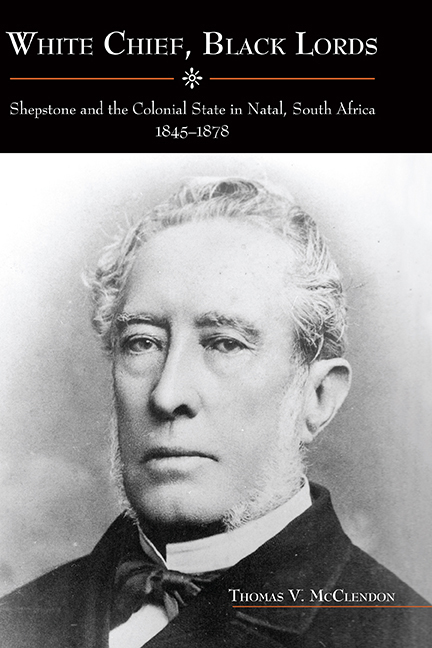Book contents
- Frontmatter
- Dedication
- Contents
- List of Illustrations
- Acknowledgments
- List of Abbreviations
- 1 Introduction
- 2 The Man Who Would Be Inkosi
- 3 Witchcraft and Statecraft
- 4 You Are What You Eat Up
- 5 Guns, Rain, and Law
- 6 From Show Trial to Shallow Reform
- 7 Conclusion
- Notes
- Glossary
- Bibliography
- Index
- Rochester Studies in African History and the Diaspora
2 - The Man Who Would Be Inkosi
Published online by Cambridge University Press: 09 May 2017
- Frontmatter
- Dedication
- Contents
- List of Illustrations
- Acknowledgments
- List of Abbreviations
- 1 Introduction
- 2 The Man Who Would Be Inkosi
- 3 Witchcraft and Statecraft
- 4 You Are What You Eat Up
- 5 Guns, Rain, and Law
- 6 From Show Trial to Shallow Reform
- 7 Conclusion
- Notes
- Glossary
- Bibliography
- Index
- Rochester Studies in African History and the Diaspora
Summary
Sir T. Shepstone was to all intents and purposes exactly like a native chieftain. He behaved like one; witness the having a snuff-box bearer.
John Kumalo, in James Stuart ArchiveThe proposition, therefore, is nothing else than that Great Britain should establish a new kingdom in South Africa [and] make Mr. Shepstone the King of that country.
Sir George Grey, Correspondence … on the Affairs of the Cape Colony, Natal, and Adjacent Territories, 1855–57Introduction
Theophilus Shepstone imagined himself leading an exodus. In 1854, Shep-stone, the secretary for native affairs (SNA) in the decade-old British colony of Natal, proposed that he lead up to half the colony's African population to an area just beyond the southern border, where he would serve, in effect, as their king. In this new domain, he would “civilize” Africans through the establishment of industrial schools and Christian missions, while continuing, as he had done in Natal, to rule through indigenous chiefs and customary law. Though higher officials eventually vetoed this proposal, it shines a bright light on some of the dynamics and contradictions of colonial rule in Africa. Essentially, Shepstone hoped to create a colonial utopia free of interference from settlers or other officials, in the process enhancing his own power and prestige but also laying what he believed to be the necessary foundations of a civilizing mission. In colonial Natalian reality, he had to consider the interests of land-hungry settlers, jealous colleagues, and a parsimonious imperial treasury, as well as the actions of subject chiefs and their followers. As a result, the colonial state was caught between civilizing imperatives and the need to rely on indigenous norms seen to be at odds with civilized virtue. Shepstone's removal proposal, though never implemented, drew on his frustrated designs for the type of colonial state he wished to create in Natal. Even though this Shepstonian utopia was meant to avoid the contradictions of colonialism, the removal proposal was invested with the same intertwined Afro-European discourses of power and the same contradictions: namely, that a state that purported to civilize, based on European standards, necessarily depended on the active and willing participation of African indigenous leaders—so-called chiefs—and the recognition of “uncivilized” African customs in a colonial legal system.
- Type
- Chapter
- Information
- White Chief, Black LordsShepstone and the Colonial State in Natal, South Africa, 1845–1878, pp. 21 - 46Publisher: Boydell & BrewerPrint publication year: 2010

